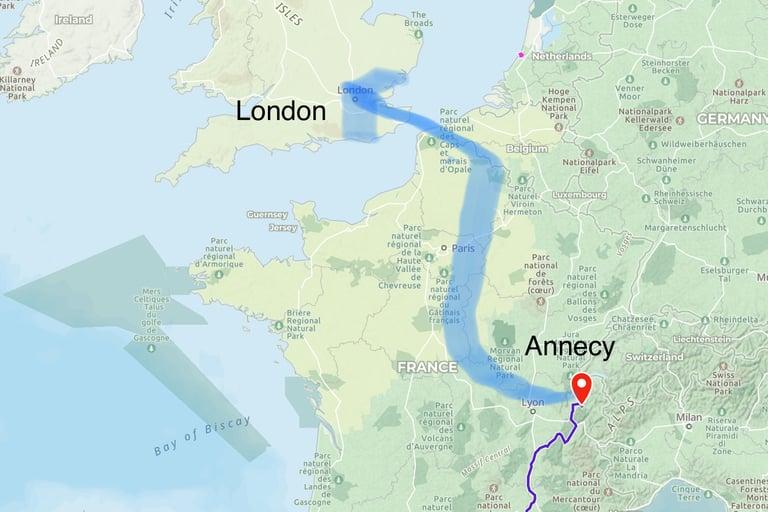Exeter
This part of the journey arose to partially satisfy the requirement not to exceed the Schengen Area visit restriction of 90 days over 6 months. This corner of England is explored by train and bicycle.
Exeter, UK, affords the opportunity to explore the southwest corner of England.
Please be patient while photos load.
They will open in a new browser window.


20230602 - London, England
The Eurostar into London Pancras International station arrived about thirty minutes late. Funny, the street clearly visible beyond a simple tape barrier was inaccessible and instead everyone went through a maze down stairs and around corners before exiting. Let us blame Brexit on that one!
The purchased London tube ticket at the self-serve ticket machine turned out a mistake. The one-way destination ticket cost £6.7! Later research reveals tapping your credit card on the yellow pads at the tube entrance and exit gates only costs £2.7. Now, if only the world could standardize! Each place requires learning a different method.
Google maps reported delays and tube train cancelations. On the Jubilee line, just as the train approaches the stop I need, the announcement made says the station is closed due to a fire. Bother! The trains are so packed I can smell the ladies hair shampoo in front of me. Begging to be let out of the train at the next stop, I backtrack and exit the underground walking instead to the hotel.
20230603 - Woking
Hmmm, a strike you say. Striking rail workers interrupted plans to travel to Exeter today. Not wanting to stay in London, a train going as far as Woking offered a way out. Never heard of Woking? Me neither, but today we'll explore it. Supposedly the trains to Exeter run tomorrow.
Woking has a long history starting circa 1100. The town is located 22 miles west of central London. Its current marketing strategy focuses on being the setting for H.G. Wells' The War of the Worlds. The Basingstoke Canal built in 1794 passes through town making it an important transportation center once. A tourist long narrow canal boat offers rides. The pleasantly shaded Saturn trail for walking or cycling parallels the canal giving one the chance to see flowers and water fowl.
A couple of miles southeast of Woking lies the town of Old Woking and the Woking Palace. The Palace fails any image of a 'palace' with only a few unimpressive walls still remaining. Apparently Henry VII converted the house, first mentioned in 1276, into a palace in 1503. You'll find the place in Google Maps but making your way there requires ignoring private road signs. After venturing so far from Woking, determination lead me to walk past a closed gate with a private sign. I should share that I'd already turned back once because of a private sign on another road and walked passed one on Carters Lane before arriving at the gate. A clear path around the closed gate presented itself so after agonizing several minutes I stepped around the gate and continued down the 'private' drive and made my way to the palace.
Lingering at Woking Palace a woman walking her dog arrived. She spoke English with an eastern European accent. (Actually, about half the people I've chatted with since arriving into the UK aren't originally from the UK as English is clearly their second language. Maybe that's one of the reason's Britains voted for Brexit to try and stop the influx - sound familiar to the southern U.S. Border?) She wasn't bothered at all by the 'private' signs pointing toward a trail and describing how it ends at Old Woking Road. A walk exploring a different route back to town through a preserve struck me as preferable to walking back on the paved 'private' drive.
This choice to take the trail won me the lottery. The trail wound loosely beside the Hoe stream through the wild preserve. I felt carried back centuries to the time Henry VII built the 'palace'. The clearly visible single track passed through open tall grass fields and then ducked through dense foliage and under massive oak trees. I never saw or came across another person even after I arrived at the Old Woking Cemetery where the trail ended.
A short stretch of walking along the somewhat busy Old Woking Road and almost having to climb over a guard rail I continued west down a path alongside the River Wey. The path seemed to terminated at a Cricket pitch with an active game in progress. I asked and was assured to just walk around the edge of the pitch where I'd find the path continuing. The players weren't the least bothered. Once around the pitch, the hiker in me turned into a spectator for a spell. The path finally ended at a bridge in a park. Passing over the bridge brought me past another Cricket match but not quite in such close proximity and then into Woking proper.
Another 9 mile walking day that I'll long remember for the charm, peacefulness, and quiet beauty. My thanks to the striking rail workers for landing me in this place on this day.
20230604 - Travel to Dawlish Warren
The rail strike may be a rolling one affecting different areas over time. The travel from Woking to Dawlish Warren went smoothly. The trains switched from electric with a third rail to diesel in Woking. The switch to the second train for the trip took place in Exeter Central station but could have happened at Exeter St Davids station. The title of this blog, Exeter, may be a misnomer as that may only be a destination passed through.
The train station of Dawlish Warren doesn't rate anything more than a platform. A small amusement park lies not far from the end of the exit ramp. The air has the sweet smell of sugar candy. One finds a beach with breakers and surfers to the left and elephant rock to the right with a sea barrier between the two. A view from elephant rock warrants the steep climb to the broad grass and bush covered top to be able looking both up the coast toward Exmouth and down toward Dawlish. Low tide leaves moored boats resting on their sides in the River Exe bay. Dawlish Warrent seems a popular destination with locals for a festival feel, the beach, minor surfing, and cheap thrill food.
The Leadstone campground only requires a 15 minute walk up the hill in the direction of Dawlish. The hosts, a husband and wife team from Inverness, are friendly. Will, the husband, accommodated my request for a shady spot.
I ate dinner at the Mt Pleasant Inn overlooking Dawlish Warren and the trains passing every five minutes (it seems). My first meal out in some time. They served typical British pub fare. The fun tidbit being the place has been in business since 1756; a reminder to me that the U.S. is a young country.
I remain amazed at the number of people around me that grew up somewhere outside of England based on the language spoken. it seems most are from India or Africa. The physical characteristics of the native Britains contrasts with that in France. The English are round, thick legs, pale, pudgy to overweight with round faces. The French are thin, angular features, bronze colored, and athletic.
20230605 - bicycle around the River Exe Estuary
The bicycling around the River Exe Estuary started with renting a bike in Dawlish Warren. Graham was very friendly and helpful adjusting the bike. The full day cost of £20 was reasonable. A couple of miles toward Exeter brings one to the community of Starcross. Taking the pedestrian flyover above the double train tracks with a short walk out to a pier brings you to the Starcross family run ferry service to Exmouth which lies across the estuary. A oneway trip cost £5. The ride takes about 15 minutes winding down the river course. The tide was on the way out and running at a good clip. There were some eddy lines forming.
The town of Exmouth rests on the River Exe and faces the English Channel. It has a nice beach area with a range of older and newer flats. A train line terminates in the community and it was beside this track for much of the journey up the east side of the River Eve Estuary that the bike path goes. A light quickening of the heart took place when about every 15 minutes a train passed even with the fences, bushes, and trees often separating the track from the path. The bike path itself delights with a smooth paved surface, stretches with tree cover, and wooden planks over boggy sections. There are a couple of tiny communities one can stop at for drink or food. The patch passes some canal locks and eventually comes to the Exeter Customs House.
The Customs House is no longer used, but is an important part of Exeter's history. Venturing further into town brings one to the Cathedral under renovation and the centre of town with a bustling shopping district. Exeter give an unusual feeling of retaining architectural elements of the very old and immediately beside very new construction. It blends well creating a small town feel yet with a modern hip element. The centre of town isn't large. It most likely stretches out further beyond what I traversed.
The cycle back took me down the west side of the River Exe and Estuary. The route was more straightforward than the east side. I came upon the Turf Hotel and if not for time growing short to return the bike would have very much enjoyed a pint on the grassy park looking south over the river and estuary. There are two locks adjacent to the hotel on the canal.
A couple of factoids:
When the Spanish tried to conquer England back in 1588 they took shelter at Calais. The English attacked so the Spanish made a hasting retreat by cutting their anchor lines and running with the wind. That's supposedly where the expression "cut and run" comes from.
When the Custom Houses were in use in England, a tool called a spit was used to look for illicit goods hidden inside other things. A spit was a hollow tube that would be inserted to pull a sample out to inspect it. That's where the expression "can't trust him as far as you can 'spit'" comes from.
Overall the loop ride was easy, away from most traffic, and with many new sites and experiences to enjoy along the way. AND, I finally made it to Exeter for a short but informative tour stopping in at the Customs House to hear and read about the history.
